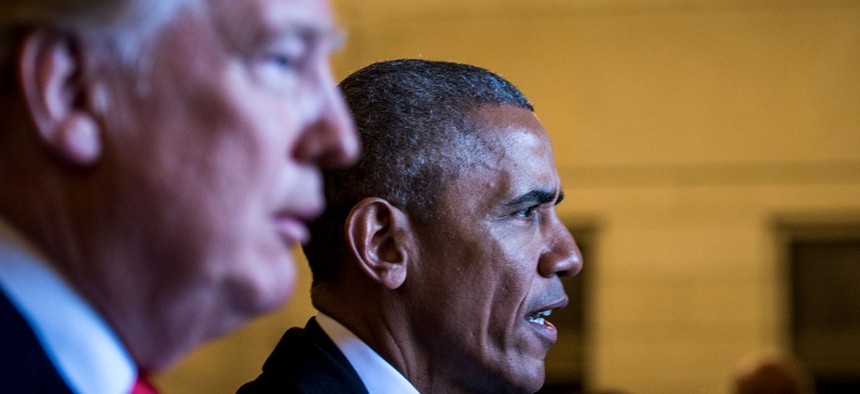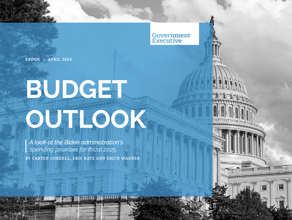As policies, both of these ideas are dubious. As politics, however, they represent notable wins for an administration that has often failed to put its policy priorities into action. Yet, like many of Trump’s biggest accomplishments, they are built on shaky foundations. Because they rely on executive action, they are likely to be overturned within the first 100 days of the next Democratic—or even Republican—presidency. Having spent much of the 2016 presidential campaign railing against Barack Obama’s executive orders, Trump seems to be making the same mistake that Obama did in relying on unilateral actions.
Analysis: Obama Warned Trump—But He Didn’t Listen
The 44th president became a devotee of unilateral presidential actions—and then saw many moves quickly reversed once he left office.
August is traditionally a slow time in Washington, but this week, President Donald Trump has already notched two major policy changes.
On Monday, the Interior Department announced changes in the way it would apply the Endangered Species Act, the landmark 1973 environmental law, which would, in effect, do less to protect endangered species and more to allow resource extraction. The same day, Ken Cuccinelli, the acting director of U.S. Citizenship and Immigration Services, announced new rules for legal immigration, which will weight the system toward immigrants who are better off and better educated, while squeezing poorer ones.
Trump’s biggest triumph remains his remaking of the federal judiciary, with his rate of appointments outpacing that of previous presidents. He has also already named two Supreme Court justices, and could possibly appoint more, even without a second term. This is a short-term political win, binding evangelicals and other conservatives wary of some of Trump’s uncouth behavior to him, and will also shape federal jurisprudence for decades to come.
But if Trump’s record of judicial appointments is perhaps the strongest in history, his legislative record is one of the weakest. Two significant laws have been passed during his presidency: a bipartisan criminal-justice-reform bill that would probably have passed under any president, and a tax cut that has proved a political flop and a deficit buster, while failing to ignite the economic growth Trump promised.
Instead of pushing for legislation, Trump has relied on unilateral executive-branch actions. During the campaign, he promised that he would “cancel every unconstitutional executive action, memorandum and order issued by President Obama.” He insisted that Obama’s orders—more notable for their scope than their number—were evidence of his failure to build a bipartisan consensus. But since then, Trump has fallen for the allure of his own executive orders, just as Obama fell for the surveillance and war-making powers that President George W. Bush created, and that Obama criticized during the 2008 campaign.
Even an abbreviated list of Trump’s executive moves shows their huge range and impact. In addition to weakening the Endangered Species Act, Trump has made a series of rule changes on environmental laws, and has sought to withdraw many rules that the Obama administration enacted. Trump has also slashed the size of two national monuments, Bears Ears and Grand Staircase–Escalante, and began the process of withdrawing the United States from the Paris Agreement. The new legal-immigration rule is only the latest in a series of major immigration shifts, including the Muslim travel ban, drastic reductions in refugee quotas, overhauls of asylum rules, and the so-called zero-tolerance policy for border crossings. Trump has been particularly prolific on trade, withdrawing the United States from the Trans-Pacific Partnership, slapping tariffs on a variety of countries for a variety of reasons, and renegotiating the North American Free Trade Agreement. He’s also pursued a range of other goals through presidential action, such as banning most transgender people from serving in the military.
One might argue, as Trump and many other Republicans did during the Obama years, that it violates the Constitution and national norms for any president to take such sweeping actions without Congress’s say-so. But whether these moves are wise as a matter of power politics is also up for debate. Because they are not enshrined in law, most of them can easily be reversed by another administration.
Already, many of Trump’s moves, especially on the environment and immigration, have been challenged in court, with mixed results. In the early months of his presidency, the administration often tried to cut corners and was stopped short by judges. Over time, though, the White House has become more careful about following federal rule-making procedures.
But what judges don’t eliminate, a new president might undo. Democratic contenders are promising to reverse many of Trump’s orders in their own first 100 days in office. Nearly every candidate has said that she or he would rejoin the Paris Agreement, for example. But even if Trump were to win reelection and then be replaced by a member of his own party in 2025, it’s easy to imagine a Republican who is less Trumpist in ideology reversing some of Trump’s orders on trade and immigration.
Not every executive action is so fragile. Trump’s withdrawal from the TPP is likely permanent. But it’s easier to tear down with executive orders than to build. The administration negotiated a replacement for NAFTA, inelegantly dubbed the U.S.-Mexico-Canada Agreement, but it still awaits congressional approval, and Democrats in the House are showing no urgency.
These potentially ephemeral achievements, and the rickety legacy they compose, are surprising because Trump began his presidency with two years of control of the House and the Senate. Republicans have since lost the House, though the Senate remains essential to the project of installing conservative judges on the bench. But Trump squandered most of that time. Despite sizable majorities, he did not obtain funding for his border wall, or enact any of the other legislation he promised in his “Contract With the American Voter,” save tax cuts. Only after Democrats won the House did Trump try to force Congress to fund the wall, and he met with predictable failure. Instead, Trump wasted months of his first two years on a series of unsuccessful attempts to repeal and replace the Affordable Care Act.
Here, too, Trump is echoing the mistakes his predecessor made. Obama entered office with Democratic control of the House and the Senate. He quickly passed a large (though arguably not large enough) economic-stimulus package. Then, like Trump, he spent months on a bruising fight on health-care reform. He paid a great price for that: It both helped foment the 2010 midterm Republican rout and also cost the president the chance to focus on other progressive priorities, such as job creation or gun control. Obama, however, managed to pass the ACA, while Trump’s quest to tear it down failed.
Once Republicans took over in 2011, Obama found his hands tied, and he began to rely more and more on his “pen and phone,” as he described executive orders. The result was a series of steps that looked like wins at the time, but that have been easy targets for Trump to reverse. Obama himself understood this, and offered Trump some helpful advice after his 2016 victory. “My suggestion to the president-elect is, you know, going through the legislative process is always better, in part because it’s harder to undo,” he said.
In 2016, Trump was contemptuous of Obama’s reliance on executive authority, loudly proclaiming that he could build a bipartisan consensus where Obama had failed. “You’re supposed to cajole, get people in a room. You have Republicans, Democrats—you’re supposed to get together and pass a law,” Trump said. “He doesn’t want to do that, because it’s too much work. So he doesn’t want to work too hard. He wants to go back and play golf.”
On Monday, as the White House announced the two latest executive actions, the president spent the day at his Bedminster, New Jersey, golf club.





